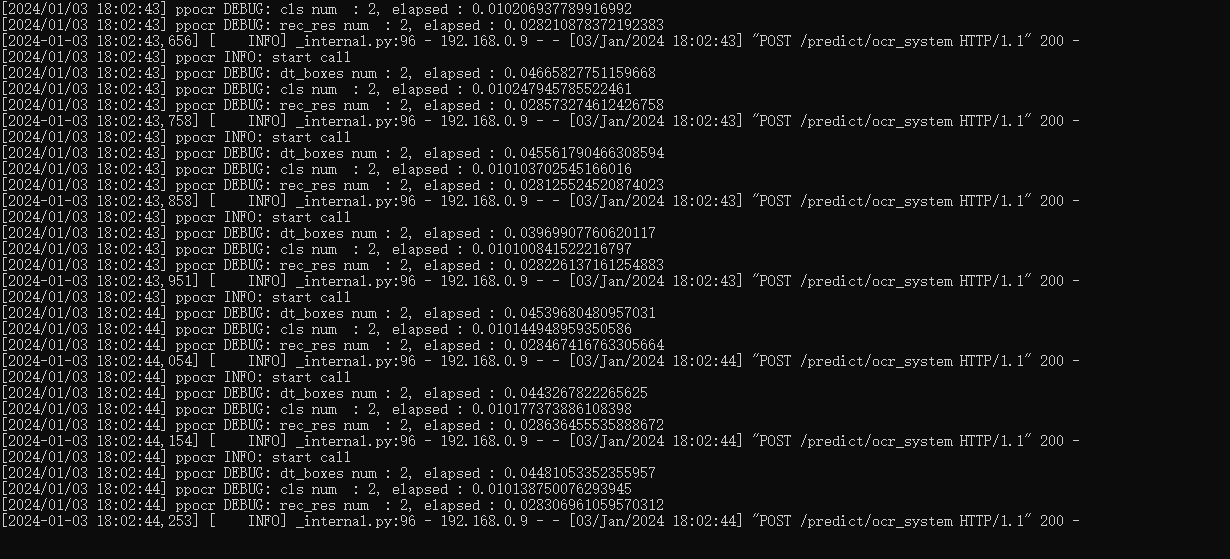paddle v4 hubserving 部署
发布时间:2024年01月03日
服务器启动命令
hub serving start -c deploy/hubserving/ocr_system/config.json
客户端请求
python tools/test_hubserving.py --server_url=server_url --image_dir=image_path
import base64
import sys
import time
import requests
import json
import asyncio
import aiohttp
import pandas as pd
from sqlalchemy import create_engine, text
import time
from PIL import Image
from io import BytesIO
import cv2
import numpy as np
import io
time1 = time.time()
def read_data():
conn = create_engine('mysql+pymysql://xxx:xxx@xxx.xxx.xx.xx:3306/x?charset=uxxxtf8')
connection = conn.connect()
page = 0
sql_select = f"SELECT * from xj_zsjh_png LIMIT {page * 10}, 100" # 1000条100s
results = pd.read_sql(sql=text(sql_select), con=connection)
out = json.loads(results.to_json(orient='records'))
img_strs_list = [x['bas64_str'] for x in out]
return img_strs_list
def cv2_to_base64(image):
return base64.b64encode(image).decode('utf8')
def save_data(results, file_name):
df = pd.DataFrame([[i['text'] for i in x] for x in results])
df.to_csv(file_name, index=False)
def process_image_(img_str):
binary = base64.b64decode(img_str)
image = Image.open(BytesIO(binary))
# 创建一个新的RGB图像,将Alpha通道设置为0
rgb_image = Image.new('RGB', image.size, (255, 255, 255))
# 将RGBA图像的颜色信息复制到RGB图像
rgb_image.paste(image, (0, 0), mask=image)
# 裁剪图片
left = 535
top = 0
right = left + 240
bottom = image.size[1]
cropped_image = rgb_image.crop((left, top, right, bottom))
# 创建一个BytesIO对象
image_bytes = io.BytesIO()
# 将图像保存到BytesIO对象中
cropped_image.save(image_bytes, format='JPEG')
return image_bytes
def main2():
results = []
img_strs_list = read_data()
for i, img_str in enumerate(img_strs_list):
image_bytes = process_image_(img_str)
data = {'images': [cv2_to_base64(image_bytes.getvalue())]}
headers = {
'Content-Type': 'application/json'
}
response = requests.post("http://192.168.0.189:8868/predict/ocr_system", data=json.dumps(data), headers=headers)
if response.status_code == 200:
res = response.json()["results"][0]
results.append(res)
else:
print('Error:', response.status_code)
save_data(results, 'normal.csv')
async def process_image(img_str):
image_bytes = process_image_(img_str)
headers = {
'Content-Type': 'application/json'
}
# 发送 OCR 请求
data = {'images': [cv2_to_base64(image_bytes.getvalue())]}
async with aiohttp.ClientSession() as session:
async with session.post("http://192.168.0.189:8868/predict/ocr_system", data=json.dumps(data),
headers=headers) as response:
if response.status == 200:
res = (await response.json())["results"][0]
return res
else:
print(f'Error: {response.status}')
return None
async def process_images(img_strs_list):
tasks = []
sem = asyncio.Semaphore(1) # 限制并发数为5 当创建过多session时就会报错
async with sem:
for img_str in img_strs_list:
task = asyncio.create_task(process_image(img_str))
tasks.append(task)
results = await asyncio.gather(*tasks)
return results
# 在主函数中调用异步任务
async def main():
img_strs_list = read_data()
results = await process_images(img_strs_list)
save_data(results, 'async.csv')
# asyncio.run(main()) #100条 8.666
main2() #100条 9.667 # 96.832
print(f'当前页 共花费--> ', round(time.time() - time1, 3), '\n') # 1.813
(异步与非异步结果差不多)
结果

文章来源:https://blog.csdn.net/weixin_38235865/article/details/135369908
本文来自互联网用户投稿,该文观点仅代表作者本人,不代表本站立场。本站仅提供信息存储空间服务,不拥有所有权,不承担相关法律责任。 如若内容造成侵权/违法违规/事实不符,请联系我的编程经验分享网邮箱:chenni525@qq.com进行投诉反馈,一经查实,立即删除!
本文来自互联网用户投稿,该文观点仅代表作者本人,不代表本站立场。本站仅提供信息存储空间服务,不拥有所有权,不承担相关法律责任。 如若内容造成侵权/违法违规/事实不符,请联系我的编程经验分享网邮箱:chenni525@qq.com进行投诉反馈,一经查实,立即删除!
最新文章
- Python教程
- 深入理解 MySQL 中的 HAVING 关键字和聚合函数
- Qt之QChar编码(1)
- MyBatis入门基础篇
- 用Python脚本实现FFmpeg批量转换
- 运放负反馈
- Golang入门必备:详解Builtin库及其应用实例
- 详解如何撰写一个基础的技术交底书
- Apache 解析漏洞(CVE-2017-15715)
- 分布式【4. 什么是 CAP?】
- 计算机毕业设计 基于SpringBoot的餐厅点餐管理系统的设计与实现 Java实战项目 附源码+文档+视频讲解
- 避免付费搜索广告系列与有机搜索广告系列之间出现关键词蚕食现象
- 关于群晖ARPL界面能出现ip但是使用Synology Assistant搜索不到ip问题 及解决方法
- 如何防止网站对用户进行识别和追踪的?
- nginx加快图片访问速度
